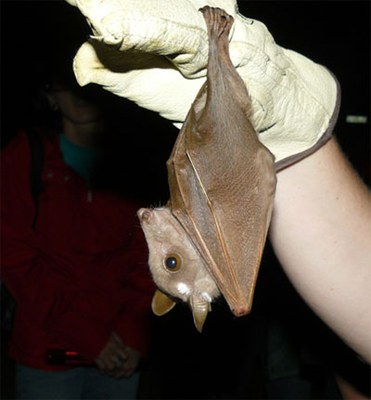Identification pointers
Fur is a light brown colour with white tufts of hair on the shoulders of males and white tufts on the head at the ears in both sexes. To the untrained eye the head may be perceived as “canine-like”, with a relatively elongated mouth, well developed teeth and large, alert eyes. Forearm length ranges between 68-95 mm and mass between 54-165 grams.
Roosting habits
Tall trees with good vegetative cover, such as a variety of fig trees and royal palms and Chinese fan palms. Under the eaves of houses or under concrete bridges have also being observed to provide roosting space (especially in Durban). They move around considerably, following food supplies and seasonality of fruits, and often roost alongside the Gambian epauletted fruit bat. Colonies are usually medium-sized but may reach up to a 100 individuals.
Breeding
Females usually have one young per year (rarely two), and births may occur throughout the year although peaks in July may occur.
Food
They eat fruit, nectar, pollen and flowers and aren’t insectivorous, unlike all the bats discussed so far. A variety of indigenous and cultivated fruit are foraged, with fig species and litchis seemingly high on their priority list. In Kenya they are known to pollinate baobab trees when feeding on the nectar of the nocturnal flowers. These flowers only open during the night and are designed to be pollinated by nocturnal animals such as fruit bats. As a multitude of animal species utilise baobabs the essential ecological role of fruit bats in Kenya is evident.






